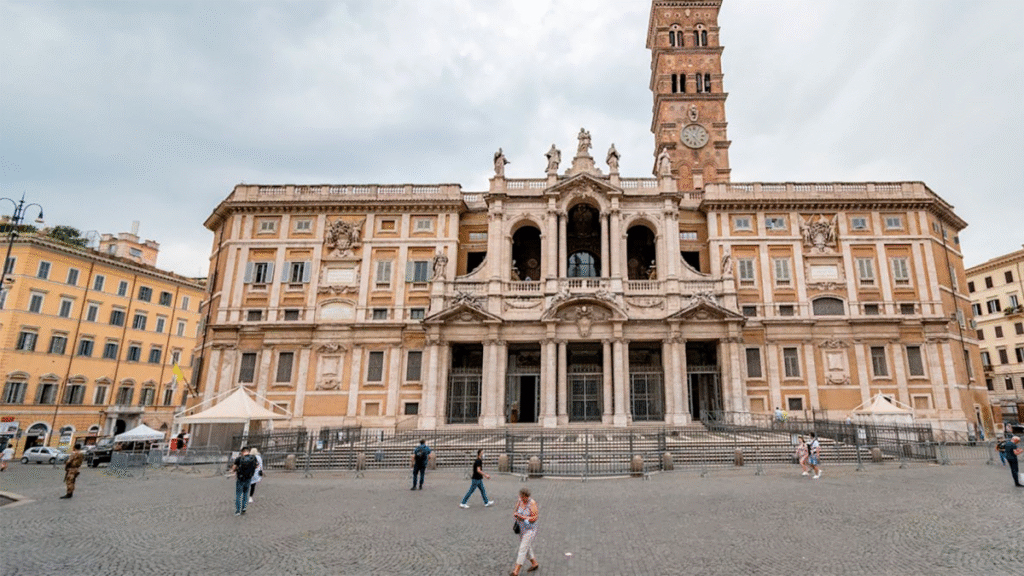A Unique Choice: Santa Maria Maggiore over San Pedro
Nestled atop Rome’s Esquilino Hill, Santa Maria Maggiore transcends its architectural value and liturgical function. Known as the oldest Western temple dedicated to the Virgin Mary, it serves as a spiritual hub. Pope Francis has selected this emblematic space for his final resting place, opting against the grandeur of St. Peter’s Basilica where most predecessors lie.
A Legendary Origin: Santa Maria Maggiore’s Founding Story
The history of Santa Maria Maggiore intertwines myth, faith, and theology. According to medieval documents and chronicles, in 358, a childless Roman couple dreamt of the Virgin, who instructed them to build an church where snow would fall in August. Simultaneously, Pope Liberius experienced the same dream. On August 5th, the mountain’s peak miraculously snowed, marking the beginning of Basílica Liberiana, later known as Santa Maria ad Nives. This annual event is celebrated with a shower of white petals during the August 5th liturgy.
From Legend to Dogma: The Significance of Santa Maria Maggiore
Beyond the legend, its foundation holds a crucial doctrinal reason: the Council of Éphèse (431) declared one of Christianity’s most profound dogmas—Mary is not only Christ’s human mother but also the Mother of God, Theotokos, “the one who gives birth to God.”
This definition, central to Christology, inspired Pope Sixtus III (432–440) to construct the first Western Marian basilica, following a paleocristian model: a central raised nave, jonian columns, a deep apse, and light flowing towards the altar as a sign of divine presence.
The Manger of Jesus in Rome’s Heart
From Teodoro I’s (642–649) pontificate, Santa Maria Maggiore became known as Sancta Maria ad Praesepem (Santa Mary of the Crib). This title reflected the presence of relics from Jesus’ manger in Bethlehem, brought to Rome from the Holy Land during the 6th and 7th centuries. According to tradition, five thin slices of sycamore wood (Ficus sycomorus) remain in the basilica, mentioned in various biblical passages and common in Palestine. These wood pieces form part of the relicary located in the crypt beneath the main altar. Veneration of these relics transformed this basilica into a Western Bethlehem, attracting pilgrims unable to visit the Holy Land.
Pope Francis’s Choice: A Symbol of Divine Accessibility
Pope Francis’s decision to rest beside the manger, where God became small, vulnerable, and accessible to the people, further resonates in this context. It symbolizes his belief that Christianity’s essence lies in making God approachable.
Seven popes chose Santa Maria Maggiore before him: Honorius III (1216–1227), Nicolas IV (1288–1292), Pius V (1566–1572), Sixtus V (1585–1590), Clement VIII (1592–1605), Paul V (1605–1621), and Clement IX (1667–1669). Many promoted reforms, expansions, or donations to the temple, with some, like Pius V or Sixtus V, maintaining a particularly close relationship with the basilica’s liturgy. Being buried there reinforced a more humble, people-centric pastoral legacy rather than the grandeur of St. Peter’s.
Santa Maria Maggiore: Rome’s Mother and Spiritual Ally
In a side chapel since the 6th century, the image of Salus Populi Romani (Protection of the Roman People) is venerated. This icon, possibly brought from the East, became part of papal liturgy as Rome’s guardian. It reportedly safeguarded the city during plagues, wars, and calamities. It was carried in procession by Gregory the Great (593), Pius V before the Battle of Lepanto (1571), and crowned Queen of the World by Pius XII (1954).
Pope Francis held deep devotion for this image, visiting over a hundred times—at the start of his pontificate in 2013 and before and after each apostolic journey. In March 2020, amid the pandemic, he walked alone through an empty Rome to pray before it. He granted the Virgin Salus Populi Romani the Golden Rose, a papal blessing symbol since the 11th century, bestowed on figures or sites of exceptional Marian importance.
Spain and Santa Maria Maggiore: A Spiritual Partnership
For centuries, Santa Maria Maggiore was considered Spain’s national church in Rome. Masses were held for kings, thanksgiving services, or vigils for the Immaculate Conception. Many students from the Spanish College of San José, founded in 1892, prayed at the tomb of St. Jerome, author of the Vulgate—the Latin vulgar Bible translation—and a key figure in Spanish theology.
Ignatius of Loyola chose Santa Maria Maggiore for his first mass as a priest. The basilica, in turn, welcomed generations of Jesuits—to which Francis belongs. In this sense, it becomes a physical extension of the Ignatian charism: a place of sending, contemplation, and trust in the Virgin.
Pope Francis’s decision is an act of spiritual consistency, capping a pontificate marked by humility and the desire for a church close to those who suffer. His legacy is inscribed within a narrative of tenderness, evangelical poverty, and fidelity to the Gospel.
Santa Maria Maggiore is more than a basilica; it’s a symbol. In times of division and uncertainty, his choice indicates a direction: returning to the origin, the manger, the Mother, as the heart of the Church.






